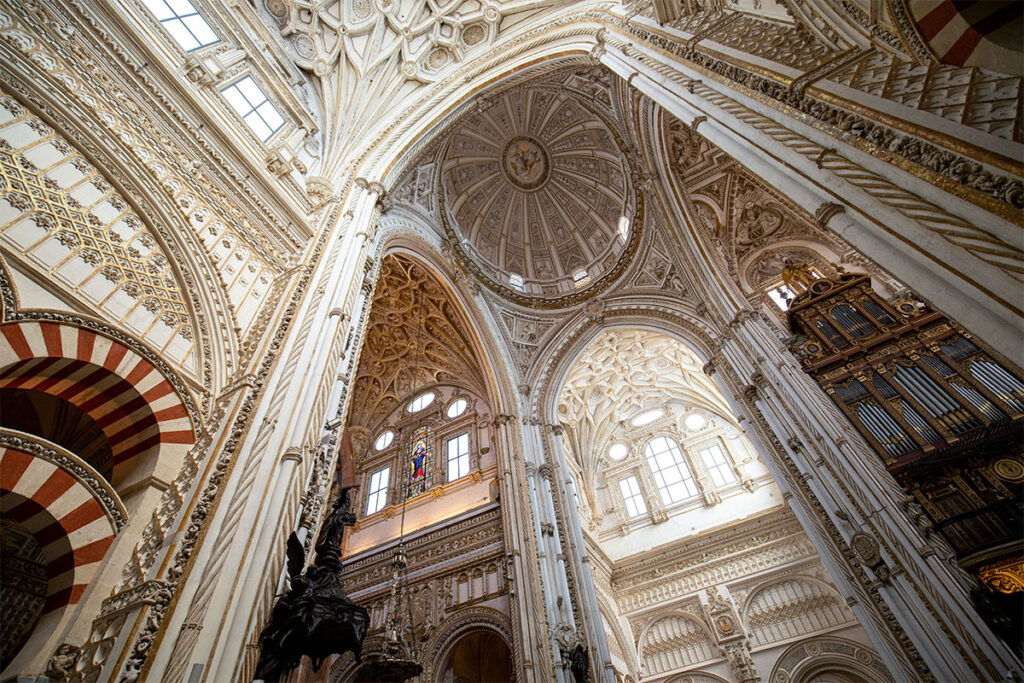Is it possible that some people visit Córdoba to see one monument only? Yes. Because you won’t find a place like this anywhere else in Europe!
The Great Mosque of Córdoba (Spanish: La Mezquita) is a unique place in virtually every respect. What impresses you at first, is its size. After all, it is one of the largest mosques in Europe! Additional space is added to it by architectural solutions (e.g. two-level arches that connect the columns), which make the building seem even larger from the inside than it really is. However, this is not the end of surprises. It may come as a real shock to some that the Grand Mosque today is no longer a Muslim temple, but a Christian cathedral. In a moment you’ll find out how it happened!
INTERESTING FACT: The Great Mosque of Córdoba was inscribed on the UNESCO World Heritage List in 1984.
History
The Great Mosque is just one of its names. In various guides you will also find it under such names as La Mezquita (transl. Mosque), La Gran Mezquita (transl. Great Mosque), La Mezquita-Catedral de Córdoba (transl. Mosque-Cathedral of Córdoba) or Catedral de Córdoba (transl. Córdoba Cathedral).
Where do these discrepancies come from? It may seem that the mosque and the cathedral are different places, but in the case of this object, their definitions have not been quite clear-cut for centuries.
To understand this phenomenon, we have to go back in time. The construction of the mosque on this site began in 786. During the reign of Muslims, and in particular during the Cordoban Caliphate, it was rebuilt and enlarged many times. Soon, the area of 23,400 m2 placed it at the top of the list of the largest mosques in the world.

After Córdoba was recaptured from the hands of Muslims, the reconstruction of the mosque and the building of a Catholic cathedral on its foundations began. As a result of this interference, a certain part of the temple was destroyed. A royal chapel (Capilla Real) and a tower with a belfry erected in the place of the former minaret were built in the Gothic-Renaissance style.
Interestingly, it was saved from further modifications to the Grand Mosque by the King of Spain, Charles V. It was he who said the words that are often quoted today: “You have destroyed something that was unique in the world and you have built what can be seen everywhere. ” Was he right? You have to judge it for yourself. It is a fact though that the effects of these changes can be considered an example of the Mudéjar style that is characteristic of Andalusia, i.e. combining elements of Islamic art with elements of Christian art.
Visiting the Great Mosque
The main attraction of La Mezquita is the so-called forest of columns. There are over 800 of them here and they are made of marble, granite and jasper. It is here that we can also admire the double arcades that connect the capitals of the columns. Another captivating place is Patio de los Naranjos, where we can see about 100 orange trees in an area of 6,500 m2. The first of them were planted in the 18th century. Finally, it is worth knowing that the Catedral de Córdoba is a non-accidental term for La Mezquita. Nowadays, this building serves as a cathedral and regular masses are held there, which you can also attend. Of course, without the camera and “tourist nonchalance” :).
INTERESTING FACT: If you want to make your visit to the Grand Mosque even more special, visit it at night. Although this type of trip is more expensive than the traditional one, it is worth the price.
Practical info
It’s best to buy tickets to the Great Mosque of Córdoba in advance. You will then avoid standing in a long queue and avoid the risk that all tickets have been sold out, which happens very often in the case of this monument.
- Address: C. Cardenal Herrero, 1, 14003 Córdoba, Spain
- Buy Tickets on GetYourGuide
